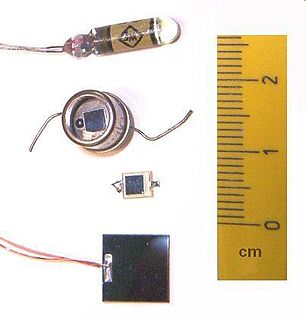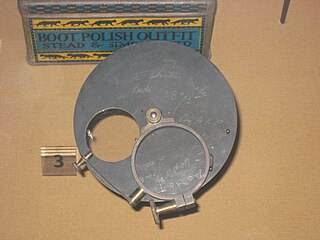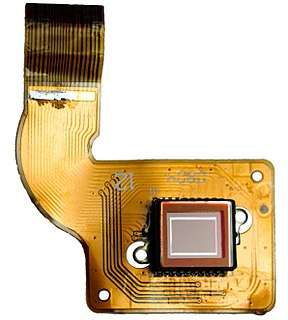
A charge-coupled device (CCD) is an integrated circuit containing an array of linked, or coupled, capacitors. Under the control of an external circuit, each capacitor can transfer its electric charge to a neighboring capacitor. CCD sensors are a major technology used in digital imaging.

A photodiode is a semiconductor p–n junction device that converts light into an electrical current. The current is generated when photons are absorbed in the photodiode. Photodiodes may contain optical filters, built-in lenses, and may have large or small surface areas. Photodiodes usually have a slower response time as their surface area increases. The common, traditional solar cell used to generate electric solar power is a large area photodiode.

In signal processing, a signal is a function that conveys information about a phenomenon. In electronics and telecommunications, it refers to any time varying voltage, current, or electromagnetic wave that carries information. A signal may also be defined as an observable change in a quality such as quantity.

A camcorder is a self-contained portable electronic device with video and recording as its primary function. It is typically equipped with an articulating screen mounted on the left side, a belt to facilitate holding on the right side, hot-swappable battery facing towards the user, hot-swappable recording media, and an internally contained quiet optical zoom lens.

A single-photon avalanche diode (SPAD) is a solid-state photodetector within the same family as photodiodes and avalanche photodiodes (APDs), while also being fundamentally linked with basic diode behaviours. As with photodiodes and APDs, a SPAD is based around a semi-conductor p-n junction that can be illuminated with ionizing radiation such as gamma, x-rays, beta and alpha particles along with a wide portion of the electromagnetic spectrum from ultraviolet (UV) through the visible wavelengths and into the infrared (IR).
A spectroradiometer is a light measurement tool that is able to measure both the wavelength and amplitude of the light emitted from a light source. Spectrometers discriminate the wavelength based on the position the light hits at the detector array allowing the full spectrum to be obtained with a single acquisition. Most spectrometers have a base measurement of counts which is the un-calibrated reading and is thus impacted by the sensitivity of the detector to each wavelength. By applying a calibration, the spectrometer is then able to provide measurements of spectral irradiance, spectral radiance and/or spectral flux. This data is also then used with built in or PC software and numerous algorithms to provide readings or Irradiance (W/cm2), Illuminance, Radiance (W/sr), Luminance (cd), Flux, Chromaticity, Color Temperature, Peak and Dominant Wavelength. Some more complex spectrometer software packages also allow calculation of PAR μmol/m2/s, Metamerism, and candela calculations based on distance and include features like 2- and 20-degree observer, baseline overlay comparisons, transmission and reflectance.

Photodetectors, also called photosensors, are sensors of light or other electromagnetic radiation.There is a wide variety of photodetectors which may be classified by mechanism of detection, such as photoelectric or photochemical effects, or by various performance metrics, such as spectral response. Semiconductor-based photodetectors typically photo detector have a p–n junction that converts light photons into current. The absorbed photons make electron–hole pairs in the depletion region. Photodiodes and photo transistors are a few examples of photo detectors. Solar cells convert some of the light energy absorbed into electrical energy.

Flat-field correction (FFC) is a technique used to improve quality in digital imaging. It cancels the effects of image artifacts caused by variations in the pixel-to-pixel sensitivity of the detector and by distortions in the optical path. It is a standard calibration procedure in everything from personal digital cameras to large telescopes.

In photography, a shutter is a device that allows light to pass for a determined period, exposing photographic film or a photosensitive digital sensor to light in order to capture a permanent image of a scene. A shutter can also be used to allow pulses of light to pass outwards, as seen in a movie projector or a signal lamp. A shutter of variable speed is used to control exposure time of the film. The shutter is constructed so that it automatically closes after a certain required time interval. The speed of the shutter is controlled by a ring outside the camera, on which various timings are marked.
In digital photography, the crop factor, format factor, or focal length multiplier of an image sensor format is the ratio of the dimensions of a camera's imaging area compared to a reference format; most often, this term is applied to digital cameras, relative to 35 mm film format as a reference. In the case of digital cameras, the imaging device would be a digital sensor. The most commonly used definition of crop factor is the ratio of a 35 mm frame's diagonal (43.3 mm) to the diagonal of the image sensor in question; that is, CF=diag35mm / diagsensor. Given the same 3:2 aspect ratio as 35mm's 36 mm × 24 mm area, this is equivalent to the ratio of heights or ratio of widths; the ratio of sensor areas is the square of the crop factor.

Image noise is random variation of brightness or color information in images, and is usually an aspect of electronic noise. It can be produced by the image sensor and circuitry of a scanner or digital camera. Image noise can also originate in film grain and in the unavoidable shot noise of an ideal photon detector. Image noise is an undesirable by-product of image capture that obscures the desired information.
A camera raw image file contains minimally processed data from the image sensor of either a digital camera, a motion picture film scanner, or other image scanner. Raw files are named so because they are not yet processed and therefore are not ready to be printed or edited with a bitmap graphics editor. Normally, the image is processed by a raw converter in a wide-gamut internal color space where precise adjustments can be made before conversion to a "positive" file format such as TIFF or JPEG for storage, printing, or further manipulation. There are dozens of raw formats in use by different manufacturers of digital image capture equipment.

An image sensor or imager is a sensor that detects and conveys information used to make an image. It does so by converting the variable attenuation of light waves into signals, small bursts of current that convey the information. The waves can be light or other electromagnetic radiation. Image sensors are used in electronic imaging devices of both analog and digital types, which include digital cameras, camera modules, camera phones, optical mouse devices, medical imaging equipment, night vision equipment such as thermal imaging devices, radar, sonar, and others. As technology changes, electronic and digital imaging tends to replace chemical and analog imaging.

An active-pixel sensor (APS) is an image sensor where each pixel sensor unit cell has a photodetector and one or more active transistors. In a metal–oxide–semiconductor (MOS) active-pixel sensor, MOS field-effect transistors (MOSFETs) are used as amplifiers. There are different types of APS, including the early NMOS APS and the much more common complementary MOS (CMOS) APS, also known as the CMOS sensor, which is widely used in digital camera technologies such as cell phone cameras, web cameras, most modern digital pocket cameras, most digital single-lens reflex cameras (DSLRs), and mirrorless interchangeable-lens cameras (MILCs). CMOS sensors emerged as an alternative to charge-coupled device (CCD) image sensors and eventually outsold them by the mid-2000s.

In digital photography, exposing to the right (ETTR) is the technique of adjusting the exposure of an image as high as possible at base ISO to collect the maximum amount of light and thus get the optimum performance out of the digital image sensor.
The merits of digital versus film photography were considered by photographers and filmmakers in the early 21st century after consumer digital cameras became widely available. Digital photography and digital cinematography have both advantages and disadvantages relative to still film and motion picture film photography. In the 21st century, photography came to be predominantly digital, but traditional photochemical methods continue to serve many users and applications.

In digital photography, dark-frame subtraction is a way to reduce image noise in photographs shot with long exposure times, at high ISO sensor sensitivity or at high temperatures. It takes advantage of the fact that two components of image noise, dark current and fixed-pattern noise, are the same from shot to shot. Noise from the image sensor include hot pixels, which light up more brightly than surrounding pixels. The technique works by taking a picture with the shutter closed and subtracting that electronically from the original photo exhibiting the noise.

In digital photography, the image sensor format is the shape and size of the image sensor.
In physics and in electronic engineering, dark current is the relatively small electric current that flows through photosensitive devices such as a photomultiplier tube, photodiode, or charge-coupled device even when no photons are entering the device; it consists of the charges generated in the detector when no outside radiation is entering the detector. It is referred to as reverse bias leakage current in non-optical devices and is present in all diodes. Physically, dark current is due to the random generation of electrons and holes within the depletion region of the device.
Correlated double sampling (CDS) is a method to measure electrical values such as voltages or currents that allows removing an undesired offset. It is used often when measuring sensor outputs. The output of the sensor is measured twice: once in a known condition and once in an unknown condition. The value measured from the known condition is then subtracted from the unknown condition to generate a value with a known relation to the physical quantity being measured.













